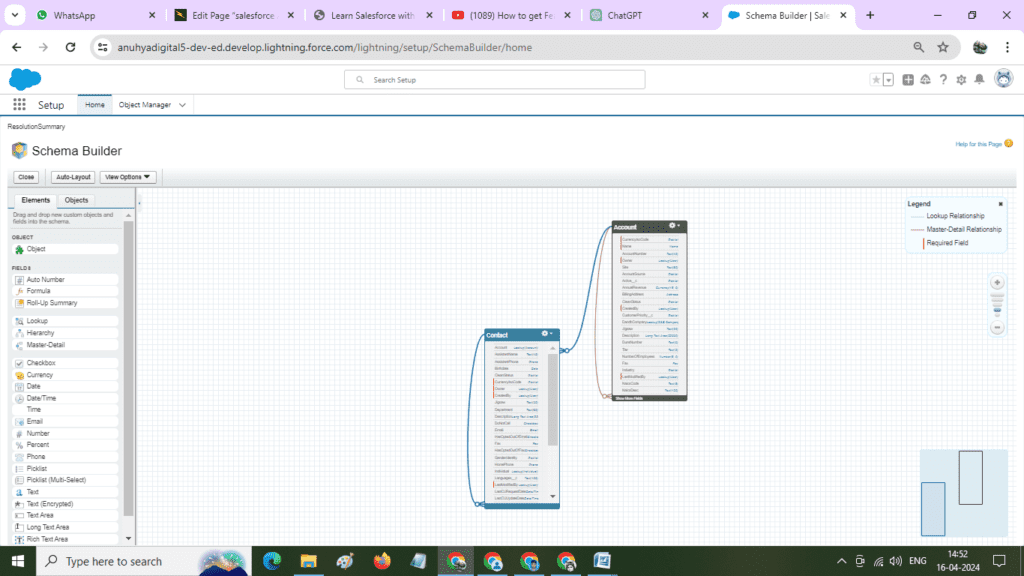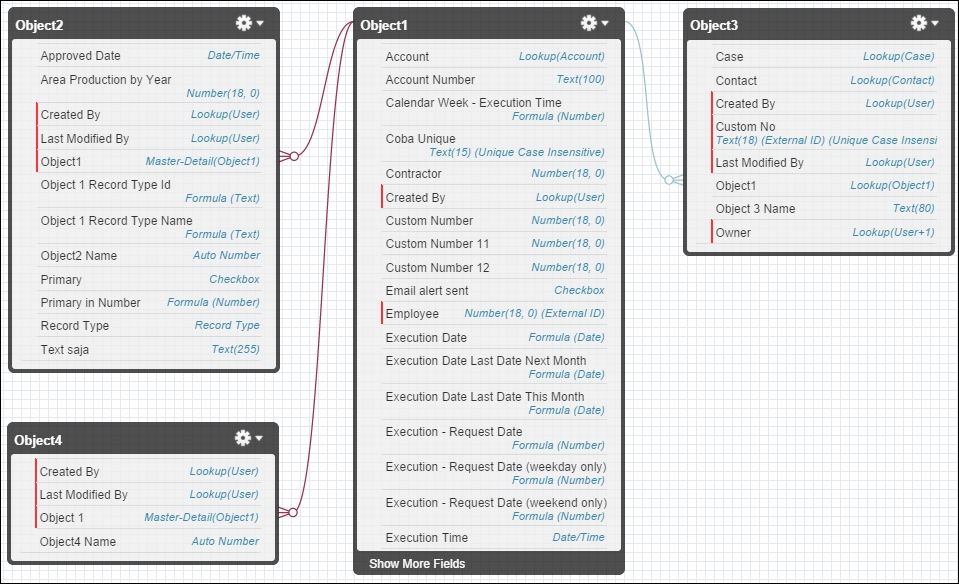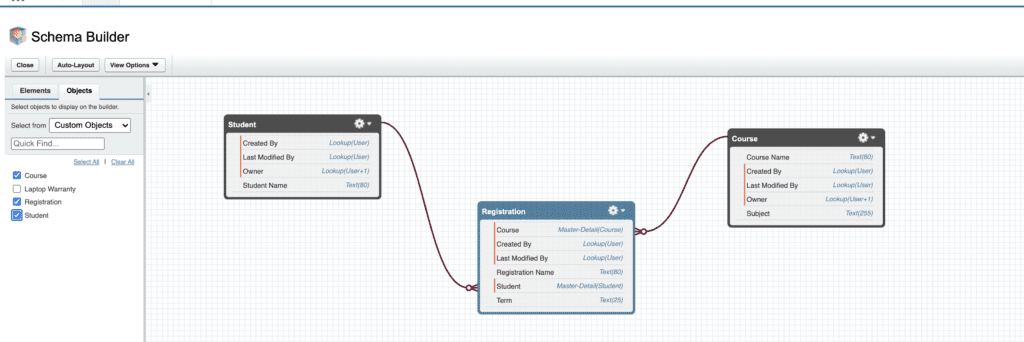Contents
- 1 What is Relationship in Salesforce
- 1.0.0.1 Introduction to relationship in salesforce:-
- 1.0.0.2 Overview of Relationships in Salesforce:-
- 1.0.0.3 Importance of Establishing Relationships in Sales:-
- 1.0.0.4 Brief History of Salesforce in Relationship Management:-
- 1.0.0.5 Types of Relationships in Salesforce:-
- 1.0.0.5.1 1. Master-detail relationship:-
- 1.0.0.5.2 Example:-
- 1.0.0.5.3 2. Lookup relationship:-
- 1.0.0.5.4 Example:-
- 1.0.0.5.5 3.self relationship:-
- 1.0.0.5.6 Example:-
- 1.0.0.5.7 4.junction relationship:-
- 1.0.0.5.8 Example :-
- 1.0.0.5.9 One-to-One Relationships:-
- 1.0.0.5.10 One-to-Many Relationships:-
- 1.0.0.5.11 Many-to-Many Relationships:-
- 1.0.0.6 Building Strong Relationships in Salesforce:-
- 1.0.0.7 Maximizing Relationships for Sales Success:-
- 1.0.0.8 Conclusion:-
- 1.0.0.9 FAQs
What is Relationship in Salesforce
In our previous blog post we had discussed about What is Field Types in Salesforce.In these blog post we discuss about What is Relationship in Salesforce
Introduction to relationship in salesforce:-
Salesforce, a leading Customer Relationship Management (CRM) software, plays a vital role in managing relationships with customers and driving sales. In this comprehensive guide, we will explore the various types of relationships in Salesforce, the importance of establishing strong connections, and strategies for maximizing sales success through effective relationship management.
Overview of Relationships in Salesforce:-
Salesforce allows users to create relationships between different objects like leads, contacts, accounts, and opportunities. By establishing connections between these entities, businesses can track interactions, understand customer preferences, and improve sales processes.
Importance of Establishing Relationships in Sales:-
Building strong relationships with customers is crucial for driving sales and fostering loyalty. With Salesforce, organizations can manage these relationships effectively, leading to increased customer satisfaction and higher retention rates.
Brief History of Salesforce in Relationship Management:-
Salesforce revolutionized the CRM industry by introducing cloud-based solutions for relationship management. Since its inception in 1999, Salesforce has been at the forefront of innovation in customer engagement and sales automation.
Types of Relationships in Salesforce:-
- Master-detail relationship
- Lookup relationship
- Self relationship
- Junction relationship
- External relationship
1. Master-detail relationship:-
Master-detail relationship is were any action taken on the parent-object is passed to child-object.
Maximum two master-detail relationship can be created.
Example:-
This example demonstrates how a master-detail relationship in Salesforce allows you to link records from one object (Opportunity) to records in another object (Account) in a hierarchical manner, providing data integrity and organizational structure within your Salesforce data model.

2. Lookup relationship:-
Lookup relationship is were any action in a parent-object does not pass to the child-object is called lookup relationship.
Maximum 40 lookup relationship can be created (38 if 2 master-detail relationship)
One to many (or) many to one.
Example:-
Lookup relationships offer more flexibility compared to master-detail relationships. You can create multiple lookup relationships between two objects, and deleting a parent record does not automatically delete associated child records

3.self relationship:-
In Salesforce, a self relationship refers to a relationship between objects of the same type. This means that a record in an object can have a relationship with another record in the same object. Self relationships are commonly used to represent hierarchical structures or to link related records within the same object.
Example:-
in a custom object called “Employee,” you might create a self relationship called “Manager” to represent the hierarchical relationship between employees and their managers. Each employee record can then have a reference to another employee record that represents their manager.

4.junction relationship:-
Connecting the two or more objects via in invisible object to create end to end relationship is called junction object
Junction object support both master-detail and lookup relationship, junction object are mostly invisible . A junction object with two master detail relationship, junction object is child object.
Many to many relationship.
Example :-
Suppose you have an object for Events and another for Attendees. An Event can have many Attendees, and an Attendee can attend multiple Events. In this case, you create a junction object, such as Event_Attendee, with master-detail relationship fields linking to both the Event and Attendee objects.

One-to-One Relationships:-
In one-to-one relationships, one record from one object is linked to one record from another object. For example, linking a contact to an account in Salesforce helps in tracking interactions and managing customer preferences.
- Definition and Examples: One-to-one relationships establish a direct connection between two records, such as linking a specific contact to an account.
- Benefits of One-to-One Relationships: Improved data accuracy, streamlined communication, and personalized interactions with customers.
- Challenges and Considerations: Ensuring data consistency, avoiding duplicate records, and maintaining data quality.
One-to-Many Relationships:-
One-to-many relationships involve linking one record from one object to multiple records in another object. This relationship type is useful for managing related data across different entities.
- Explanation and Use Cases: One-to-many relationships allow for linking a single account to multiple opportunities, streamlining sales processes and enhancing data accessibility.
- Advantages of One-to-Many Relationships: Centralized data management, efficient reporting, and better insights into customer interactions.
- Best Practices for Managing One-to-Many Relationships: Establish clear data hierarchies, maintain data integrity, and utilize Salesforce automation tools for streamlined processes.
Many-to-Many Relationships:-
In many-to-many relationships, multiple records from one object can be linked to multiple records in another object. This relationship type is beneficial for managing complex interactions and associations.
- Definition and Implementation in Salesforce: Many-to-many relationships enable organizations to establish intricate connections between various entities, such as linking multiple leads to multiple campaigns.
- Benefits of Many-to-Many Relationships: Enhanced data visibility, improved collaboration among teams, and better tracking of cross-functional relationships.
- Strategies for Handling Many-to-Many Relationships Effectively: Utilize junction objects, establish clear data mappings, and leverage Salesforce reporting capabilities for comprehensive insights.
you want to know more about the relationships click here
Building Strong Relationships in Salesforce:-
Data Quality and Consistency:-
Maintaining accurate data is essential for building and nurturing relationships in Salesforce. Data quality ensures that businesses have access to reliable information for effective decision-making.
- Importance of Accurate Data in Relationships: Reliable data drives targeted marketing efforts, personalized customer interactions, and informed sales strategies.
- Methods for Maintaining Data Integrity: Implement data validation rules, deduplication tools, and regular data cleansing practices.
- Tools for Data Management in Salesforce: Utilize Salesforce Data Loader, Data Import Wizard, and Data.com for effective data management and maintenance.
Communication and Collaboration:-
Effective communication is key to fostering strong relationships with customers. Salesforce offers various tools and features for seamless communication and collaboration within organizations.
- Effective Communication with Customers: Leverage Salesforce Email Templates, Chatter, and Community Cloud for personalized communication and engagement with customers.
- Collaborative Workspaces in Salesforce: Create shared workspaces using Salesforce Files and Chatter Groups to facilitate collaboration among team members and enhance productivity.
- Integrating Communication Channels for Better Relationships: Integrate external communication platforms like Email, SMS, and Social Media with Salesforce for a comprehensive view of customer interactions.
Automation and Personalization:-
Balancing automation with personalization is crucial for building meaningful relationships with customers. Salesforce automation tools help businesses streamline processes while maintaining a human touch in customer interactions.
- Leveraging Automation for Relationship Management: Use Salesforce Workflow Rules, Process Builder, and Lightning Flow for automating routine tasks and nurturing customer relationships.
- Customizing Salesforce for Personalized Interactions: Implement Personalization Builder, Einstein AI, and Marketing Cloud for tailoring communication and offerings based on customer preferences.
- Balancing Automation with Human Touch in Sales Relationships: Combine automated workflows with personalized interactions to create engaging customer experiences and build lasting connections.
Maximizing Relationships for Sales Success:-
Using Relationships to Drive Sales:-
Strong relationships are instrumental in driving sales revenue and business growth. Salesforce provides the tools and insights needed to leverage relationships for sales success.
- Strategies for Leveraging Relationships in Sales: Implement Account-Based Selling, Opportunity Management, and Lead Scoring in Salesforce to prioritize relationships and drive sales conversions.
- Tracking and Measuring Relationship ROI: Utilize Salesforce Reports and Dashboards, Campaign Influence, and ROI tracking to measure the effectiveness of relationship-building efforts.
- Integrating Relationship Management with Sales Strategies: Align relationship management practices with sales objectives, KPIs, and revenue goals for a holistic approach to customer engagement.
Handling Challenges in Relationship Management:-
Managing customer relationships comes with its set of challenges. Salesforce offers solutions to address conflicts, reduce customer churn, and rebuild broken relationships effectively.
- Addressing Conflict in Customer Relationships: Utilize Salesforce Case Management, Service Cloud, and Customer Feedback tools to resolve issues, address complaints, and enhance customer satisfaction.
- Dealing with Customer Churn and Retention: Implement Churn Prediction Models, Customer Loyalty Programs, and Retargeting Strategies using Salesforce tools to reduce customer churn and improve retention rates.
- Strategies for Rebuilding Broken Relationships in Salesforce: Leverage Automated Surveys, Customer Journey Mapping, and Engagement Strategies to re-engage with dissatisfied customers and rebuild trust.
Future Trends in Relationship Management:-
As technology evolves, businesses need to adapt to emerging trends in relationship management to stay ahead of the competition and meet changing customer expectations.
- Emerging Technologies in Salesforce for Relationships: Explore Chatbots, Virtual Assistants, and AI-powered analytics in Salesforce for enhanced customer interactions and relationship building.
- Predictive Analytics for Relationship Building: Utilize Predictive Lead Scoring, AI-driven Forecasting, and Customer Behavior Analytics to anticipate customer needs and personalize engagements.
- Adapting to Changing Customer Needs and Expectations: Stay agile and responsive to changing market trends, customer preferences, and technological advancements to maintain strong relationships and drive sales success.
Conclusion:-
Summary of Key Points:-
In conclusion, understanding relationships in Salesforce is essential for effective customer engagement and sales success. By leveraging different types of relationships, maintaining data quality, enhancing communication, balancing automation with personalization, and maximizing sales strategies, businesses can build strong customer relationships that drive revenue growth.
Reflecting on the Importance of Relationships in Salesforce:-
Relationships lie at the core of every successful business. By prioritizing customer relationships and investing in relationship management strategies within Salesforce, organizations can achieve long-term success, foster brand loyalty, and drive sustainable growth.
Recommendations for Effective Relationship Management in Sales:-
For businesses looking to excel in Salesforce relationship management, it is crucial to focus on data quality, communication, automation, and personalization. By implementing best practices, addressing challenges proactively, and embracing future trends, organizations can cultivate meaningful relationships that lead to sales success.
FAQs
- How can Salesforce help in managing relationships with customers?
Salesforce provides a centralized platform for tracking customer interactions, preferences, and behaviors, enabling businesses to build strong relationships through personalized communication and targeted marketing strategies.
- What are the common challenges faced in relationship management using Salesforce?
Common challenges include data inconsistencies, communication gaps, automation errors, and customer dissatisfaction. Salesforce offers tools and solutions to address these challenges and enhance relationship management practices.
- How can businesses measure the success of their relationships in Salesforce?
Businesses can measure relationship success by tracking customer engagement metrics, conversion rates, satisfaction scores, and revenue generated through relationship-building efforts. Salesforce reporting and analytics tools offer insights into relationship ROI and effectiveness.
In our next blog post we will discuss about What is Lookup Relationship in Salesforce

3 thoughts on “What is Relationship in Salesforce”